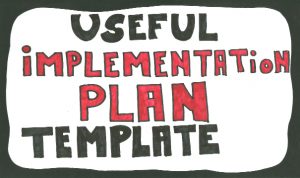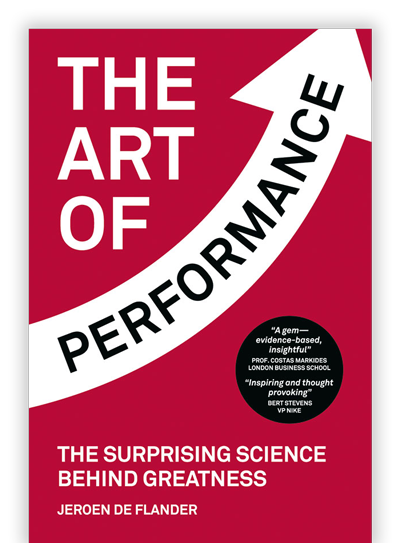Strategy implementation is a crucial component to strategy success. But often, it’s the strategy implementation plan most leaders struggle with.
In collaboration with the Institute for Strategy Execution, we developed a simple implementation plan template to help you implement your strategy.
In this strategy implementation mini-guide, I will introduce the strategy implementation template and explain each of the implementation plan steps in more detail.
You can download the complete strategy implementation plan template for free at the bottom of my site (pop-up)
- Strategy implementation plan methodology: the Canvas
- Strategy implementation plan steps & exercises
- Strategy implementation plan PPT

Strategy implementation plan template: The Canvas
Here’s an overview of the core elements of the strategy implementation plan template.
I will explain each step in more detail in the next section of this strategy implementation guide.

Strategy implementation plan template: steps & exercises
Now it’s time to zoom in on the different steps of the strategy implementation plan template.
Strategy implementation plan steps. #1: The list of NOES
The first strategy implementation plan exercise helps you to clarify the strategy by identifying what your team / your company is not going to do.
Your challenge:
Identify the 5 things your team / your company is not going to do in the next 12 months.
Tips:
- I suggest a 12-month time frame, similar to the budget cycle. But you can make it shorter or longer
- If you do the ‘List of Noes’ exercise with a team, let everyone identify their 5 noes individually, write them on yellow Post-its. Let each member comment on their choices. After a discussion, evolve towards one list
- Review the list after the chosen time period
- Your list is not set in stone. If something drastic happens, you can change. But it needs to be done with care, as the main goal of this exercise is to protect the long-term choice against short-term pressure
Strategy Implementation plan steps. #2: H3 Communicator
Every strategy has trade-offs, like quality versus costs or speed versus accuracy, more focus on one client group to the detriment of another.
It’s quite easy to identify and talk about these trade-offs at a macro level (it’s important for our company to focus on quality, while keeping our costs under control), but it gets quite tricky once you try to balance these trade-offs at the individual daily decision level (how much can I spend to improve the quality?).
This third implementation plan template exercise helps you solve individual decision dilemmas.
Your challenge
Identify trade-offs for a specific group, provide decision guidance, and wrap a story around it.
Steps:
- Identify the strategy trade-offs
- By job family, provide decision guidelines
- Wrap a story around it
- Share the stories. Stories bypass our critic mode. They go straight for the heart.
Strategy Implementation plan steps. #3: The Balanced Scorecard
The fourth implementation plan template exercise helps you break down your strategy into objectives along 4 different perspectives:
- Financial Perspective
- Customer Perspective
- Internal Process Perspective
- Learning and Growth Perspective
Your challenge:
Break down the strategy into team objectives
Tips:
Check out this long list of Balanced Scorecard tips. It’s one of the most popular mini-guides on this blog.
Strategy Implementation plan steps. #4: strategy progress – The Finish Line & Signposts
Here we do two strategy implementation plan template exercises closely linked together. First, we define the finish line. Next, we select signpost.
A finish line is a destination postcard that captures the core of the strategy and shows everyone in an inspiring way what strategy success looks like.
This strategy implementation exercise helps you to show everyone what strategy success looks like. By adding a finish line, you make strategy success tangible for everyone.
Your challenge:
Capture the core of the strategy in a simple, inspiring sentence.
Tips:
- Go for a finish line 3-5 years down the line
- Go for a finish line that inspires the whole team, not only the shareholders
- Go for a finish line that’s tough, but realistic. A finish line isn’t a day-dream—like winning the lottery jackpot one day. A finish line is a statement that starts from realistic potential
- Make sure you can track and communicate progress easily
Once you have identified your finish line, the most important KPI, it’s time to select the other indicators.
The signpost exercise will help you to select a limited set of lead indicators for each job family and clean up each dashboard.
Your challenge:
Identify 1 signpost/lead indicator for each job family
Tips:
- Try to get rid of as many useless indicators as possible. Ask yourself each time: “What important decision does this measure help us take?” The word ‘important’ is important. It’s tempting to answer ‘yes’, but it’s a question of how important. It’s like the temperature indicator you see on an airplane’s onboard TV. It’s cool to know it’s extremely cold outside, but it won’t get you any faster to your destination. Or think about the tachometer on the dashboard of a fancy car. This indicator shows the engine rotation rate, typically with markings indicating the safe range. They’re cool to look at when you fire away, but you don’t need them to know when to shift gears as the sound of your engine will tell you that (and those who do maybe shouldn’t be driving a manual car).
- A second crucial element to avoid information overload. How? Make a distinction between the information needs of the coach and those of the players. The coaching dashboard—your dashboard—is the easy part. Our focus should be on the players’ scoreboard. For our journey, we need to build a simple dashboard for our travelers—a dashboard that visualizes the finish line and the signposts, the lead indicators that predict success at the finish line. As you know, not every player contributes to success in the same way. In football, the defense has a different role to the offense. In soccer, the keeper is different to the field players. In baseball, the pitcher is different to the fielding team. We therefore need several smaller player dashboards, each adapted to the specific role of each group of travelers. In an organization, for example, sales reps and operations share the same finish line, but have a different set of signposts.
Strategy Implementation plan steps. #5: Your Must Win Projects
This strategy implementation plan template exercise challenges you to identify existing and future projects. Pick the 3 most important and detail them on 1 page.
Your challenge:
Select 3 Must-win projects and detail them on 1 page.
Tips:
Topics that need to be included in the project on 1 page:
- Project Background
- Problem Statement
- Objectives
- Deliverables
- Core Members
- Assumptions/Constraints
- Issues/Risks
Strategy Implementation plan steps. #6: Habits
Ask 100 CEO’s, “Is having the right company culture crucial to succeed in business?” and most will answer ‘yes.’ But putting the right culture in place is a major challenge. “Culture eats strategy for breakfast every day,” management guru Peter Drucker said. To successfully complete our strategy journey, we have to tackle the culture change challenge.
When strategy meets culture on the battlefield, strategy arrives with a clear disadvantage. And that’s because new decisions demand willpower—a scarce resource—and existing ones don’t. If we want to avoid the same failure rate, if we want to avoid our strategy becoming a nice breakfast, we need to automate the crucial decisions that support our strategy as quickly as possible. That way, travelers don’t tap into their willpower when they execute the new strategy.
In short, we need to identify and kill automated behavior (habits) that kill our progress towards our finish line and identify and boost new behavior, creating new habits that accelerate our journey.
Your challenge:
Identify 2 habits (automated behaviors) you see in the team that block progress and identify two habits that that team would help to speed up.
Tips:
- Ask people individually to write the +2/-2 habits on Post-its and discuss the results with the team.
- Run a short survey providing a list of behaviors people can score on today on the desired situation.
The 3 bottom boxes are not so much related to the strategy implementation process but help you master the people dynamics. I cover those in a different guide about change management. Here’s a short video explaining the bad guys.
Strategy Implementation plan template PowerPoint (PPT)
Each of these strategy implementation plan template exercises is supported with a longer document covering templates for each individual exercise. As a reader of this blog, you can download them for free at the bottom of this page (pop-up)
Like these tips to build and use an simple implementation plan template?
Want to help others master the strategy implementation process?
Share now!



